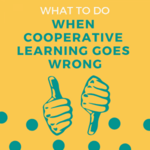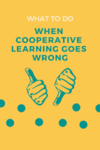
Cooperative learning is wonderful, but what do you do when cooperative learning goes wrong?
When students are working together in cooperative groups there are a number of things that can go wrong, but when you know how to prevent and deal with issues as they arise cooperative learning strategies can be a powerful part of your classroom routine.
When Cooperative Learning Goes Wrong, Pause
I’ll set the scene…
You explain an activity to students and set them free to get to work with their cooperative groups, but soon you notice things seem to be going awry. Something just isn’t quite right.
Take a moment and pause the class as a whole. I am a big fan of using the lights to signal a pause in the classroom. I simply turn off the lights (we had several windows in our room so the room was still well lit even without any overhead lights) and students knew their eyes needed to find me.
Once you have students’ attention take the moment to tell students you are pausing because you noticed that not everyone was working cooperatively and following the steps of the intended structure.
This pause serves as a warning and a reset to let students know you are listening and watching and to get down to business.
When Cooperative Learning Goes Wrong, Restart
If you have already tried pausing the class and the cooperative learning activity is still going off the rails it is time for a hard restart. Think of this as the equivalent of turning it off and back on again.
Call students away from their cooperative groups to a whole group area such as the carpet. This is the opportunity for you to tell students what you were seeing that wasn’t quite right and reset the expectations for an activity.
This adjustment might be anything from a voice level different to the actual steps of a cooperative learning strategy.
When Cooperative Learning Goes Wrong, Model
Many times the actual steps of a cooperative learning strategy might turn into a stumbling block, especially when it is a new strategy for your class.

Take the opportunity to model the strategy using your students as examples. A great strategy for modeling is to have the students who are struggling the most be the models for the class. It puts the onus on them to understand the steps in the strategy and share it with their group.
If more instruction is needed you may choose to also provide non-examples, but I would caution to stick to the positive examples especially when using students as models.
When Cooperative Learning Goes Wrong, Table It
When cooperative learning goes so wrong that you can’t reset the activity with a pause, restarting the activity, or modeling the strategy it might be time to move on.
The truth is not every activity is going to work with every group of students and you, as the teacher, needs to judge when it is time to abandon an activity and try something else.
This does NOT mean to never do cooperative learning activities with this class again. It means to take a break from cooperative learning, especially a new to your students strategy, for a little while and go back to it later.
Want to Know More About Cooperative Learning?
Are you looking for more cooperative learning information? Check out this post with a treasure trove of cooperative learning research, strategies, and information!
Join the newsletter

Subscribe to our newsletter and receive this FREE 7 Continents Jigsaw cooperative learning activity and get started with cooperative learning strategies today!
